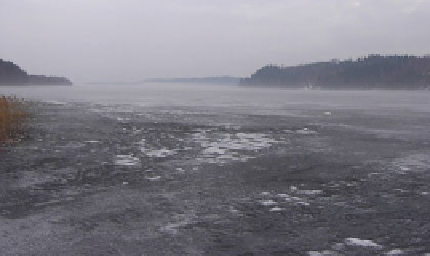Geoscience Reference
In-Depth Information
4.1.2 Solar Radiation
The level of solar radiation on the Earth
s surface depends on time, latitude, clear sky
the incoming solar radiation is divided into three parts (Fig.
3.17
): absorption at the
surface QT,
s0
, transmission through the surface into the snow/ice/water medium QT,
T
, and
outgoing back to atmosphere QT
r
, Q
s
= Q
s0
+ Q
T
+ Q
r
. The outgoing radiation is expressed,
using the albedo, as Q
r
=
'
ʱ
the surface is
Q
T
1
a
c
¼
ð
4
:
5
Þ
ð
Þ
Q
s
In thermodynamics, it means that the net solar radiation (1
-
ʱ
)Q
s
is decomposed to the
fraction 1
taken as an
internal source term. It has become custom to assume that light forms the transmitted part,
while shorter and longer wavelengths are absorbed near the surface (within a few centi-
metres); then
-
ʳ
, taken into the surface boundary conditions, and to the fraction
ʳ
ʳ ≈
ʳ
is fairly stable and not sensitive to cloudiness
or solar zenith angle. Infrared radiation is strongly absorbed by pure ice or water, and
ultraviolet is usually taken care by CDOM in lake waters (see Sect.
3.4
). Ice and snow, as
well as very clear lake water, however, are poor in CDOM and to add ultraviolet in the
penetrating part the fraction
ʳ
should be higher by about 0.03.
Albedo is a critical factor in the heat budget. It varies widely (e.g., Arst et al. 2006),
and its parameterization for modelling applications is an unsolved, tough question
surface. In open water conditions, albedo is low and stable, while in the ice season,
scattering is strong that produces the high level of albedo. These variations are due to the
surface type (snow or ice), presence of liquid water, and the thickness of snow and ice.
Especially in the melting season, the variability of albedo is large in space and time
(Fig.
4.2
). This is due to a positive feedback mechanism in the system. A disturbance in
0.45
-
0.50. The fraction
Fig. 4.2
In the melting period,
lake ice surface is patchy



Search WWH ::

Custom Search